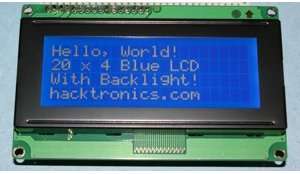I’ve always been interested in monitoring my local weather, and noticed the difference between what weather.com and accuweather.com think my local weather is, and what I see out the window. I also wanted better control over my heating and A/C system. As a computer and electronics nut, I’ve been playing with the Arduino Microcontroller, and decided to to meld my interests. So here goes the documentation on my home built solar powered weather station (always being modified, and expanded) with HVAC Control.
Demo
Step 1 The Arduino

Arduino is an open-source electronics prototyping platform based on flexible, easy-to-use hardware and software. It’s intended for artists, designers, hobbyists, and anyone interested in creating interactive objects or environments. – http://arduino.cc/
The Arduino requires 5v to run, and we supply this with our Pico Solar PV / Lithium battery pack.
Step 2 The LCD Display

// character LCD example code
// www.hacktronics.com
// Connections:
// rs (LCD pin 4) to Arduino pin 12
// rw (LCD pin 5) to Arduino pin 11
// enable (LCD pin 6) to Arduino pin 10
// LCD pin 15 to Arduino pin 13
// LCD pins d4, d5, d6, d7 to Arduino pins 5, 4, 3, 2
LiquidCrystal lcd(12, 11, 10, 5, 4, 3, 2);
int backLight = 13; // pin 13 will control the backlight
void setup()
{
pinMode(backLight, OUTPUT);
digitalWrite(backLight, HIGH); // turn backlight on. Replace ‘HIGH’ with ‘LOW’ to turn it off.
lcd.begin(16,2); // columns, rows. use 16,2 for a 16×2 LCD, etc.
lcd.clear(); // start with a blank screen
lcd.setCursor(0,0); // set cursor to column 0, row 0 (the first row)
lcd.print(“Hello, World”); // change this text to whatever you like. keep it clean.
lcd.setCursor(0,1); // set cursor to column 0, row 1
lcd.print(“hacktronics.com”);
// if you have a 4 row LCD, uncomment these lines to write to the bottom rows
// and change the lcd.begin() statement above.
//lcd.setCursor(0,2); // set cursor to column 0, row 2
//lcd.print(“Row 3”);
//lcd.setCursor(0,3); // set cursor to column 0, row 3
//lcd.print(“Row 4”);
}
void loop()
{
}
See http://www.hacktronics.com/Tutorials/arduino-character-lcd-tutorial.html for actual code as instructables breaks our include statements.
Step 3 Temperature & Humidity
I purchased a SHT21 Temperature Humidity sensor from MisensO.com. This chip uses the I2C protocol for communicating. I found some sample code on the net that makes it talk to the Arduino, but it outputs to the serial port back to the pc. I modified the code to output to my LCD. I now have the Temperature and Humidity showing on the LCD display.
//Tested with SHT21 Breakout from Misenso
//SHT21 pin SDA to Arduino Analog pin 4
//SHT21 pin SCL to Arduino Analog pin 5
//SHT21 pin GND to Arduino GND
//SHT21 pin VCC to Arduion 3v (not 5v)
lcd.begin(20,4); // columns, rows. use 16,2 for a 16×2 LCD, etc.
lcd.clear(); // start with a blank screen
lcd.setCursor(0,0); // set cursor to column 0, row 0 (the first row)
lcd.print(“Humidity: “); // change this text to whatever you like. keep it clean.
lcd.print(humidity.GetHumidity());
lcd.setCursor(0,1); // set cursor to column 0, row 1
lcd.print(“Temp in C: “);
lcd.print(humidity.GetTemperatureC());
lcd.setCursor(0,2); // set cursor to column 0, row 2
lcd.print(“Temp in F: “);
lcd.print(humidity.GetTemperatureF());
See http://arduinotronics.blogspot.com/2010/09/our-temperature-humidity-monitor-is.html for actual code as instructables breaks our include statements. You will need the LibHumidity.h library from Modern Devices for this project.
Step 4 HVAC Control
Now that I know what the temperature is, I need to control my A/C and heat based on what I want the temp to be. I installed a RGB LED as a placeholder for the relays I will be installing. If the system calls for heat, it turns the LED red. If it calls for cooling, it turns the LED Blue. If it’s in our comfort range, it turns green.
if (humidity.GetTemperatureF() < 60)
{
digitalWrite(RedLEDPin, LOW); // sets the Red LED on
digitalWrite(BlueLEDPin, HIGH); // sets the Blue LED off
digitalWrite(GreenLEDPin, LOW); // sets the Green LED off
}
else if (humidity.GetTemperatureF() >= 75)
{
digitalWrite(BlueLEDPin, LOW); // sets the Blue LED on
digitalWrite(RedLEDPin, HIGH); // sets the Red LED off
digitalWrite(GreenLEDPin, HIGH); // sets the Green LED off
}
else
{
digitalWrite(GreenLEDPin, LOW); // sets the Green LED on
digitalWrite(BlueLEDPin, HIGH); // sets the Blue LED off
digitalWrite(RedLEDPin, HIGH); // sets the Red LED off
}
See http://arduinotronics.blogspot.com/2010/09/our-temperature-humidity-monitor-is.html for actual code as instructables breaks our include statements.
For more Detail: The Arduino Weather Station / Thermostat using ATmega328 microcontroller
